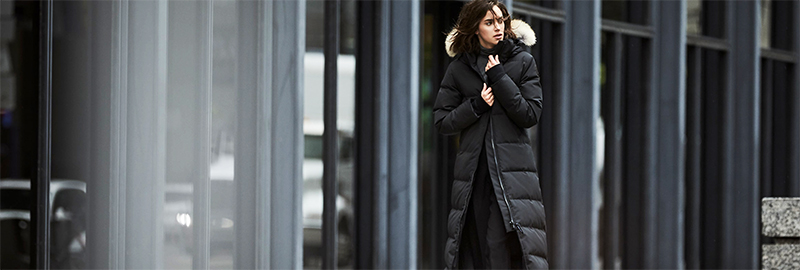By Eric Smith
<span style="color: #999999;">Despite Canada Goose Holdings Inc.’s upbeat second quarter—which included revenues doubling in Asia—its shares tumbled $4.22, or 10.8 percent, to $34.82 at market close Wednesday on the news that political turmoil in Hong Kong is disrupting the company’s operations and sales.
Earlier in the day, Canada Goose (GOOS) stock had been down in the low double digits—even after the company posted an earnings and revenue beat in Q2 on strength across channels and geographies, and even after the company maintained guidance for the fiscal year.
Simply put, the unrest in Hong Kong, where Canada Goose has a significant presence, had investors wary.
“The situation has intensified since our last call,” President and CEO Dani Reiss admitted to analysts on Wednesday morning’s earnings call. “The impact on tourism and retail traffic, the performance of our store and IFC [International Finance Centre, where Canada Goose’s store is located] has impacted it significantly. The same goes for a recently opened location at Ocean Center which is a fifth of our nine openings this year. With this addition, we are established in the two most important luxury retail districts in the city, complementing the mix of guests we’ve already reached through IFC. Although we wish that the situation was different today, we’re developing markets and building stores for decades, not just for the next quarter.”
Still, Canada Goose in Q2 managed to double revenue in Asia to $48.9 million, topping the company’s other regions. U.S. revenue grew 38.5 percent on a constant-currency basis, and Canada revenue grew 29.9 percent “against tough comparisons at our most developed market,” Reiss said.
Reiss said the company is monitoring the Hong Kong chaos and working to maintain some semblance of business cohesion there amid the tumult.
“We’re watching the situation closely and evaluating actions to streamline our cost base on the ground, including negotiating accommodations from landlords,” he said.
And despite the hit to shares, Canada Goose did post a nice quarter, something Reiss was quick to point out when discussing the period’s performance.
“Fortunately, during our second quarter, strong top-line performances in other markets offset the impact in Hong Kong,” he said.
Indeed they did. Canada Goose reported earnings rose 24.5 percent in the fiscal second quarter ended September 29 as sales grew 27.7 percent to C$294 million. Earnings and revenue topped Wall Street’s targets, and the outerwear maker maintained its guidance for the year.
<span style="color: #999999;">By channel, direct-to-consumer revenue increased to $74.2 million, driven by incremental revenue from new retail stores. And wholesale revenue increased to $219.8 million, driven by higher-order values from existing partners, complemented by customer requests for earlier shipment timing relative to last year.
Wholesale growth also reflects incremental revenue from Baffin in its peak quarter. Canada Goose acquired the footwear brand in November 2018.
Meanwhile, DTC gross profit was $56.1 million, a gross margin of 75.6 percent. The 40 bps increase in gross margin reflects the net positive impact of pricing relative to costs. And wholesale gross profit was $104.3 million, a gross margin of 47.5 percent. The 290 bps decrease in gross margin reflects a normalization relative to the second quarter of fiscal 2019, which was elevated due to the timing of production efficiencies and reductions in import duties on goods sold in Europe.
“Our performance in the first half reflects the strength of our brand and the power of our unique business model. Through global brand equity, selective distribution and operational flexibility, we delivered another set of strong results despite continuing external uncertainties,” Reiss said. “Alongside continued growth at home, we are making great strides internationally, and we believe we are well-positioned going into our peak selling season.”
Click here for more about Canada Goose’s Q3 earnings.

The company Wednesday reiterated the fiscal 2020 outlook it issued on May 29. As a reminder, here are some highlights of what Canada Goose issued then:
For fiscal 2020, the company expects:
- Annual revenue growth of at least 20 percent
- Adjusted EBIT margin expansion of at least 40 basis points
- Annual growth in adjusted net income per diluted share of at least 25 percent
Key assumptions underlying the fiscal 2020 outlook above are as follows:
- Wholesale revenue growth in the high-single-digits on a percentage basis
- Eight new retail stores in operation by the end of the winter selling season
- One new digital concept store in operation by the end of the winter selling season, which will be an experiential showroom to drive local e-commerce sales in the Greater Toronto Area. It is not expected to generate revenue or operating income at a level consistent with the company’s traditional retail store format.
- Materially larger losses in adjusted EBIT and adjusted net income per diluted share during the fiscal first quarter, due to a larger number of retail stores operating during off-peak periods and higher corporate SG&A investments to support growth, including local market activation ahead of planned retail openings, new product and Greater China operations.
- Capital expenditures of $75 million including investments in new retail stores, IT and manufacturing capacity.
Photos courtesy Canada Goose
















